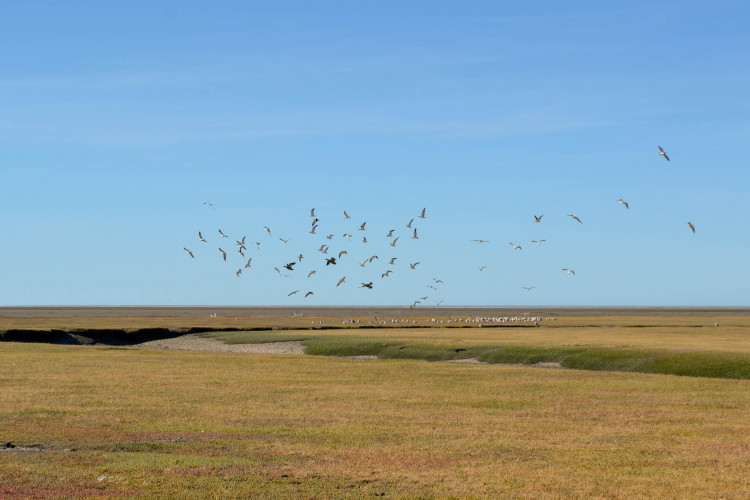Costa Atlántica Reserve
The Atlantic Coast Reserve was created to ensure the continuity of the wintering areas of migratory shorebirds.
How to get here
Se puede acceder a la zona de la reserva comprendida en la ciudad de Río Grande, desde la ruta nacional 3, destacándose un pequeño sendero de interpretación, ubicado en la costanera de dicha ciudad, entre las calles Córdoba y Lima. Desde Río Grande a San Sebastián por ruta nacional 3, 80 Km pavimentados.
¿Are you in Tierra del Fuego? Check how to get here from your location
directions_walk directions_carLocation: It is located on the north coast of the province of Tierra del Fuego, extending from Cabo Nombre, north of San Sebastián Bay, to the mouth of the Ewan River to the south.
Conservation value:
The Atlantic Coast Reserve was created in 1998 to protect the wintering areas of shorebirds, which are migratory birds that spend the northern winter moving to the austral summer. These birds need the intertidal flats to obtain their food, and the coastal lands for their rest and protection.
On the other hand, coastal waters harbor economically important fish species such as bass, pejerrey and fueguina sardine. In addition, they constitute the feeding and displacement zone of three species of seabirds of the South-West Atlantic, which breed in other protected areas or areas of interest. These are the yellow tufted penguin, which nests in the Island of the States Reserve, and the Magellanic penguin, which nests on Martillo Island, but outside the breeding season, between April and September, they use the waters located in front of the Reserve. Atlantic Coast as a dispersal and feeding area. The other species is the southern giant petrel, which uses the waters of the reserve to move during the breeding season. Numerous marine mammals use the waters to feed themselves.
What services does it offer?
You can access different points of interest and viewpoints from the City of Rio Grande.
Description:
The Atlantic Coast Reserve covers an approximate distance of 220 kilometers, covering an area of 28,600 hectares. The north of San Sebastián Bay, Cabo Nombre, marks the northern limit of the reserve and represents the most important coastal accident, since it is one of the areas of greatest ecological significance of the reserve. It is a wide bay with low coasts, with extensive muddy and sandy intertidal zones, partially closed by the El Páramo Peninsula. The area of Punta Sinaí is characterized by the existence of a field of erratic blocks, product of the quaternary glaciation, of high scenic value.
The waters of the Patagonian shelf originate in the cold waters of the Malvinas Current, and in the inland waters of the Strait of Magellan and the great Patagonian rivers. The nutrient richness of the cold waters and the large differences in tides contribute to the richness of Patagonian waters. The general relief of the Reserve is characterized by the extent of the tidal flats and the presence of restingas, which are wave erosion platforms. The climate is of the cold temperate type with an average temperature of 11ºC for the warmest month and -1ºC for the coldest. Strong west winds "whip" the area, with extreme speeds of up to 200 km / h. Most of the land area adjacent to the reserve corresponds to the Tierra del Fuego steppe, where the coirón (Festuca gracillima) is the dominant species. Murtilla (Empetrum rubrum) and black bush (Chiliotrichum difussum) are also observed. In floodable sites we can see bushes of green bush (Lepidophillum cupressiforme) that alternate with patches of a fleshy plant (Salicornia ambiguas). Towards the south, and already in the broad steppe forest-mountain range ecotone appear patches of forest of ñire (Nothofagus antarctica), which occupy the high parts of the land.
The greatest wealth of the reserve is in its avifauna. It is notable for its abundance of migratory shorebirds that come from the northern hemisphere, such as the sea scholarship (Limosa haemastica), the red-billed plover (Calidris canutus) and the white-rumped sandpiper (Calidris fuscicollis). The coasts of the City of Rio Grande is home to, in addition to migratory birds, populations of the southern oystercatcher (Haematopus leucopodus), the common cauquén (Chloephaga picta), the coastal cauque (Chloephaga hybrida), the brown-headed gull (Larus maculipennis), the large swallow tern (Sterna hirundinacea), the cook gull (Larus dominicanus), among others. The red head cauquén (Chloephaga rubidiceps), endangered species, inhabits the northern area of the Big Island, and also reaches its shores.
As in the entire Patagonian coast, the waters of the reserve are inhabited by macroalgae mattresses, among them the cachiyuyo, a brown alga that forms extensive forests, where crustaceans, molluscs and fish live and reproduce. Around 21 species of cetaceans reproduce and feed in the waters of the area.
The city of Rio Grande, the only nearby urban center, being the rest of the adjacent lands occupied by the extensive sheep farming activity.
Creation story:
The reserve has a high historical value linked to the development and occupation of the Selk'nam culture and also of older societies. Likewise, this coastal zone presents testimonies of the colonization by the white man and his connection to the native peoples.
The Atlantic Coast Reserve of Tierra del Fuego was created in the first instance by Provincial Decree in 1992 with the primary objective of conserving migratory shorebirds and their habitats. In 1998 its status as a protected area was reaffirmed through the enactment of Provincial Law 415, by which it was assigned the category of "Natural Coastal Reserve". It also constitutes a Hemispheric Site of the Hemispheric Reserve Network for Shorebirds - a program destined to the protection of migratory birds and their habitats in the American continent. It was also incorporated into the List of Wetlands of International Importance established by the RAMSAR Convention. The creation of the Atlantic Coast Reserve contributes to the conservation objectives of other protected areas or species; but mainly it will help sustain tourist activities as in the case of Isla Martillo. Put another way, the fate of several emblematic animal species of Patagonia depends on what happens in the waters of the Atlantic Coast Reserve.





